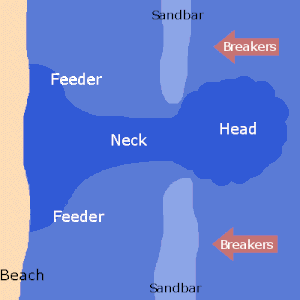
Back تيار ساحب Arabic Мъртво течение Bulgarian খরস্রোত জোয়ার Bengali/Bangla Zpětný proud Czech Çыранран хăвалакан юхăм (рип) CV Revlehul Danish Brandungsrückstrom German Corriente de resaca Spanish Erresaka Basque جریان شکافنده Persian


A rip current (also rip) is a specific type of water current that can occur near beaches where waves break. A rip is a strong, localized, and narrow current of water that moves directly away from the shore by cutting through the lines of breaking waves, like a river flowing out to sea. The force of the current in a rip is strongest and fastest next to the surface of the water.[1]
Rip currents can be hazardous to people in the water. Swimmers who are caught in a rip current and who do not understand what is happening, or who may not have the necessary water skills, may panic, or they may exhaust themselves by trying to swim directly against the flow of water. Because of these factors, rip currents are the leading cause of rescues by lifeguards at beaches. In the United States they cause an average of 71 deaths by drowning per year as of 2022[update].
A rip current is not the same thing as undertow, although some people use that term incorrectly when they are talking about a rip current. Contrary to popular belief, neither rip nor undertow can pull a person down and hold them under the water. A rip simply carries floating objects, including people, out to just beyond the zone of the breaking waves, at which point the current dissipates and releases everything it is carrying.
- ^ "Rip Current Characteristics". College of Earth, Ocean, and Environment, University of Delaware. Archived from the original on 26 July 2013. Retrieved 16 January 2009.
© MMXXIII Rich X Search. We shall prevail. All rights reserved. Rich X Search